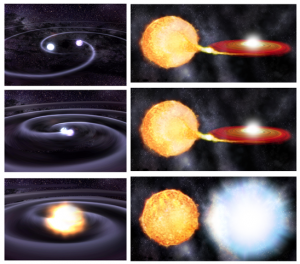 Type Ia supernovae (SNe) are often the archetype of an astronomical standardizable candle — something that has a known luminosity which we can use to measure its distance. Scientists famously used type Ia SNe to discover that our universe is accelerating and won the Nobel prize in 2011. However, one of astronomy’s dirtiest secrets is that we don’t know exactly how type Ia SNe materialize or why they might even be standard candles.
Type Ia supernovae (SNe) are often the archetype of an astronomical standardizable candle — something that has a known luminosity which we can use to measure its distance. Scientists famously used type Ia SNe to discover that our universe is accelerating and won the Nobel prize in 2011. However, one of astronomy’s dirtiest secrets is that we don’t know exactly how type Ia SNe materialize or why they might even be standard candles.
Supernovae are the explosive deaths of stars. They have a range of spectral types and energies that depend on the nature of the explosion and the progenitor stars. Type Ia SNe detonate in one of two ways: via the single degenerate or double degenerate model. In the single degenerate model, a white dwarf orbits a massive main-sequence star and eats aways at its partner’s outer layers. The white dwarf gains mass and eventually tips over the Chandrasekhar limit and collapses on itself and explodes. In the double-degenerate model, a binary system of two white dwarfs loses energy due to gravitational waves and the white dwarfs eventually collide.
Read the article on Astrobites

